Just another five minutes of exercise a day on top of your usual activity could be enough to noticeably shift blood pressure in a downward direction, new research has found.
High blood pressure is classified as having a reading of 140 millimeters of mercury (mmHg) or higher when blood is being pumped through the arteries – known as systolic pressure – and 90 mmHg or greater when the heart is diastolic, or at rest.
Just a few minutes of activity that gets your heart rate up, such as cycling or climbing stairs, was estimated to lower systolic blood pressure by 0.68 mmHg and diastolic blood pressure by 0.54 mmHg, the data showed.

Also known as hypertension, the condition carries an increased risk of serious health problems, including heart attacks and kidney damage.
"The good news is that whatever your physical ability, it doesn't take long to have a positive effect on blood pressure," says first author and epidemiologist Jo Blodgett from University College London.
"What's unique about our exercise variable is that it includes all exercise-like activities, from climbing the stairs to a short cycling errand, many of which can be integrated into daily routines."
The study was based on a week of activity data and blood pressure readings collected using wearable devices on 14,761 participants.
Daily activity was split into six types: sleep, sedentary behavior, slow walking, fast walking, standing, and vigorous exercise. These daily patterns were then referenced against blood pressure, with several other potential influences (including age and sex) factored in.
The researchers then calculated some 'what if' scenarios – how changing those habits could change blood pressure. For example, a 2 mmHg improvement in SBP was estimated if exercise replaced 21 minutes of sedentary time or 21 minutes of fast walking a day.
"For those who don't do a lot of exercise, walking did still have some positive benefits for blood pressure," says Blodgett. "But if you want to change your blood pressure, putting more demand on the cardiovascular system through exercise will have the greatest effect."
As an observational study involving multiple variables, no direct causal link can be drawn. Nevertheless, as the team analyzed data from a large group of people, there's a strong indication that just a small amount of exercise could affect blood pressure (which other studies have suggested too).
Given the relatively small amount of time needed, and the variety of straightforward exercises that make a difference, the international team behind the research hopes these findings can help the 1.28 billion adults worldwide with hypertension.
"The finding that doing as little as five extra minutes of exercise per day could be associated with measurably lower blood pressure readings emphasizes how powerful short bouts of higher intensity movement could be for blood pressure management," says joint senior author Emmanuel Stamatakis, a professor of physical activity and population health at the University of Sydney.
The research has been published in Circulation.
